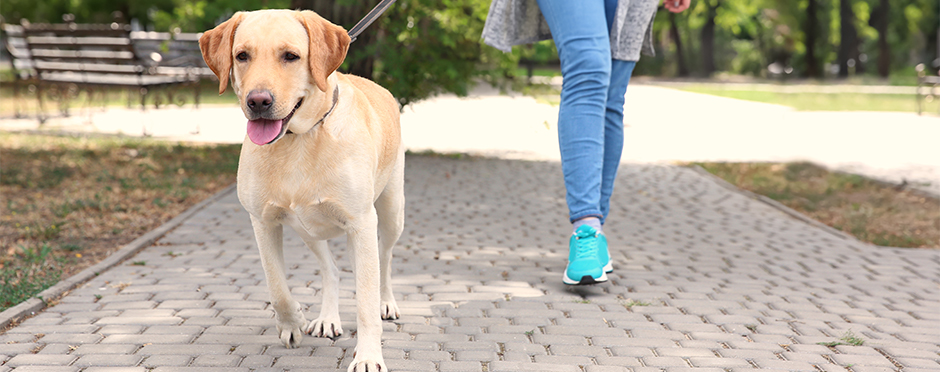
9 Ways to Prevent Injury While Walking the Dog
1 CommentWhat’s not to love about man’s best friend? In addition to an unbreakable bond, dog ownership comes with many health benefits! Did you know adults that own dogs have fewer chronic diseases, fewer doctor visits and decreased limitations with daily activities?1 Those who own dogs also walk fifty percent more on average, compared to non-dog owners.2
On the other hand, injuries incurred “while walking the dog” are on the rise. 1,671 adults presented to the emergency room (ER) after a dog-walking injury in 2004. In 2017, that number increased to 4,396 – a 150% increase in just 13 years!3 The majority of those injured were women (79%) and over the age of 65.3 The most common dog-walking injuries are hip fracture and wrist/upper arm fracture, but tendon injuries of the hand/finger, skin tears and bruises and hematomas have also been reported.1
Here are a few tips on how to prevent injuries while taking Fido on his daily stroll:
1. Don’t wrap the leash around your fingers.
If your dog darts away, you won’t have time to reposition your fingers in time to prevent an injury.4 Potential injuries could include finger fracture and/or dislocation and ligament or tendon rupture. Be sure the leash is held around the palm of the hand rather than intertwined in the digits.
2. Avoid putting your fingers underneath your dog’s collar.
If the dog suddenly jumps or pulls, you’re at risk for twisting your fingers. A simple twist can cause a finger dislocation and/or fracture.4
3. Train your dog to walk on a leash properly.5
This may help any access pulling that could cause a potential fall.
4. Use a short leash and avoid retractable leashes.
Short leashes are preferred over retractable leashes as they provide you more control. In addition, if you are walking two dogs simultaneously, use a double leash to avoid a tangle, as a tangle between multiple leashes could result in a potential trip or fall.6
5. Wear the right footwear.
A sturdy pair of tennis shoes is preferable over sandals or shoes with high heels that could lead to potential trips, falls, etc. If it’s raining or cold outside, a good pair of boots with traction is a great choice.
6. Be attentive at all times while walking.
Don’t text, talk on the phone, or use social media on your mobile device with your furry friend’s leash in hand.
7. Walk during daylight hours, and choose walking surfaces that are in good condition.
Avoid walking on trails, grass, slick surfaces, etc. that could cause you to lose your balance.
8. Know your limits.
Make sure that your dog’s personality (aggressive or calm), size (large or small), and the number of dogs being walked at once match your physical abilities.
9. Hire a dog walker.
There are tons of resources available online including dog walking and pet sitter services.
We all love spending time with our pets. It’s important to remember these safety tips to minimize the risk of injury. If you experience any pain or injuries or have questions related to the hand or upper extremity, contact an Athletico occupational therapist for a free assessment.
Athletico is now offering appointments in-clinic or virtually through telehealth. Request your free assessment using the button below.
The Athletico blog is an educational resource written by Athletico employees. Athletico bloggers are licensed professionals who abide by the code of ethics outlined by their respective professional associations. The content published in blog posts represents the opinion of the individual author based on their expertise and experience. The content provided in this blog is for informational purposes only, does not constitute medical advice and should not be relied on for making personal health decisions.
References:
1. Lowry, K., & Rosen, T. (2020, April). Dog Walking Can Be Hazardous to Cutaneous Health. Dermatology, 105(4), 191-194.
2. Gretebeck, K., Radius, K., Black, D., Gretebeck, R., Ziemba, R., & Glickman, L. (2020). Dog Ownership, Functional Ability, and Walking in Community-Dwelling Older Adults. Journal of Physical Activity and Health, 10(5), 646-655.
3. Yee, B. (2019, March 6). How Dog Walking Injuries Are Increasing Among Older Adults. In Forbes. Retrieved from https://www.forbes.com/sites/brucelee/2019/03/06/how-dog-walking-injuries-are-increasing-among-older-adults/#4e6dfca59c48.
4. Cohen, M., & Fernandez, J. (n.d.). 6 Ways to Prevent Common Dog Walking Injuries. In Discover Wellness. Retrieved from /health-wellness/discover-health/preventing-dog-walking-injuries.
5. Brulliard, K. (2019, March 6). Dog-walking can be hazardous for seniors, study suggests. In The Washington Post. Retrieved from https://www.washingtonpost.com/science/2019/03/06/dog-walking-can-be-hazardous-seniors-study-suggests/.
6. “The Most Common Dog Walking Injuries.” Performance Physical Therapy, 1 Oct. 2019, www.performanceptri.com/post/the-most-common-dog-walking-injuries.

1 Comment
Monika
These tips are essential for keeping both dogs and owners injury-free while walking. I especially appreciate the advice on proper leash handling to avoid strain.